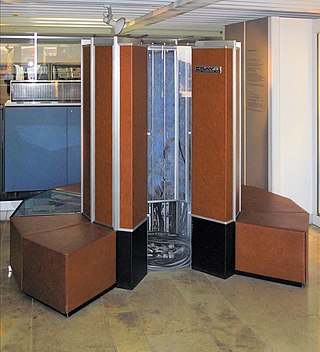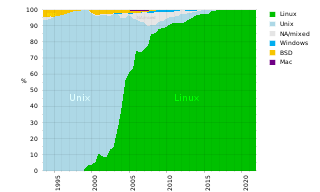
Seymour Roger Cray was an American electrical engineer and supercomputer architect who designed a series of computers that were the fastest in the world for decades, and founded Cray Research which built many of these machines. Called "the father of supercomputing", Cray has been credited with creating the supercomputer industry. Joel S. Birnbaum, then chief technology officer of Hewlett-Packard, said of him: "It seems impossible to exaggerate the effect he had on the industry; many of the things that high performance computers now do routinely were at the farthest edge of credibility when Seymour envisioned them." Larry Smarr, then director of the National Center for Supercomputing Applications at the University of Illinois said that Cray is "the Thomas Edison of the supercomputing industry."

The Cray-1 was a supercomputer designed, manufactured and marketed by Cray Research. Announced in 1975, the first Cray-1 system was installed at Los Alamos National Laboratory in 1976. Eventually, eighty Cray-1s were sold, making it one of the most successful supercomputers in history. It is perhaps best known for its unique shape, a relatively small C-shaped cabinet with a ring of benches around the outside covering the power supplies and the cooling system.
Control Data Corporation (CDC) was a mainframe and supercomputer firm. CDC was one of the nine major United States computer companies through most of the 1960s; the others were IBM, Burroughs Corporation, DEC, NCR, General Electric, Honeywell, RCA, and UNIVAC. CDC was well-known and highly regarded throughout the industry at the time. For most of the 1960s, Seymour Cray worked at CDC and developed a series of machines that were the fastest computers in the world by far, until Cray left the company to found Cray Research (CRI) in the 1970s. After several years of losses in the early 1980s, in 1988 CDC started to leave the computer manufacturing business and sell the related parts of the company, a process that was completed in 1992 with the creation of Control Data Systems, Inc. The remaining businesses of CDC currently operate as Ceridian.

The CDC 6600 was the flagship of the 6000 series of mainframe computer systems manufactured by Control Data Corporation. Generally considered to be the first successful supercomputer, it outperformed the industry's prior recordholder, the IBM 7030 Stretch, by a factor of three. With performance of up to three megaFLOPS, the CDC 6600 was the world's fastest computer from 1964 to 1969, when it relinquished that status to its successor, the CDC 7600.

The IBM 7030, also known as Stretch, was IBM's first transistorized supercomputer. It was the fastest computer in the world from 1961 until the first CDC 6600 became operational in 1964.
William Charles Norris was an American business executive. He was the CEO of Control Data Corporation, at one time one of the most powerful and respected computer companies in the world. He is famous for taking on IBM in a head-on fight and winning, as well as being a social activist who used Control Data's expansion in the late 1960s to bring jobs and training to inner cities and disadvantaged communities.
Cray Inc., a subsidiary of Hewlett Packard Enterprise, is an American supercomputer manufacturer headquartered in Seattle, Washington. It also manufactures systems for data storage and analytics. Several Cray supercomputer systems are listed in the TOP500, which ranks the most powerful supercomputers in the world.

The ETA10 is a vector supercomputer designed, manufactured, and marketed by ETA Systems, a spin-off division of Control Data Corporation (CDC). The ETA10 was an evolution of the CDC Cyber 205, which can trace its origins back to the CDC STAR-100, one of the first vector supercomputers to be developed.

The history of computing is longer than the history of computing hardware and modern computing technology and includes the history of methods intended for pen and paper or for chalk and slate, with or without the aid of tables.

The CDC 7600 was the Seymour Cray-designed successor to the CDC 6600, extending Control Data's dominance of the supercomputer field into the 1970s. The 7600 ran at 36.4 MHz and had a 65 Kword primary memory using magnetic core and variable-size secondary memory. It was generally about ten times as fast as the CDC 6600 and could deliver about 10 MFLOPS on hand-compiled code, with a peak of 36 MFLOPS. In addition, in benchmark tests in early 1970 it was shown to be slightly faster than its IBM rival, the IBM System/360, Model 195. When the system was released in 1967, it sold for around $5 million in base configurations, and considerably more as options and features were added.
The Cray Operating System (COS) is a Cray Research operating system for its now-discontinued Cray-1 (1976) and Cray X-MP supercomputers. It succeeded the Chippewa Operating System, and was the Cray main OS until replaced by UNICOS in the late 1980s. COS was delivered with Cray Assembly Language (CAL), Cray FORTRAN (CFT), and Pascal.

The CDC 8600 was the last of Seymour Cray's supercomputer designs while he worked for Control Data Corporation. As the natural successor to the CDC 6600 and CDC 7600, the 8600 was intended to be about 10 times as fast as the 7600, already the fastest computer on the market. The design was essentially four 7600's, packed into a very small chassis so they could run at higher clock speeds.

The CDC STAR-100 is a vector supercomputer that was designed, manufactured, and marketed by Control Data Corporation (CDC). It was one of the first machines to use a vector processor to improve performance on appropriate scientific applications. It was also the first supercomputer to use integrated circuits and the first to be equipped with one million words of computer memory.

The CDC 3000 series are a family of mainframe computers from Control Data Corporation (CDC). The first member, the CDC 3600, was a 48-bit system introduced in 1963. The same basic design led to the cut-down CDC 3400 of 1964, and then the 24-bit CDC 3300, 3200 and 3100 introduced between 1964 and 1965. The 3000 series replaced the earlier CDC 1604 and CDC 924 systems.

The CDC 1604 is a 48-bit computer designed and manufactured by Seymour Cray and his team at the Control Data Corporation (CDC). The 1604 is known as one of the first commercially successful transistorized computers. Legend has it that the 1604 designation was chosen by adding CDC's first street address to Cray's former project, the ERA-UNIVAC 1103.

The CDC 6000 series is a discontinued family of mainframe computers manufactured by Control Data Corporation in the 1960s. It consisted of the CDC 6200, CDC 6300, CDC 6400, CDC 6500, CDC 6600 and CDC 6700 computers, which were all extremely rapid and efficient for their time. Each is a large, solid-state, general-purpose, digital computer that performs scientific and business data processing as well as multiprogramming, multiprocessing, Remote Job Entry, time-sharing, and data management tasks under the control of the operating system called SCOPE. By 1970 there also was a time-sharing oriented operating system named KRONOS. They were part of the first generation of supercomputers. The 6600 was the flagship of Control Data's 6000 series.
SCOPE is a series of Control Data Corporation batch operating systems developed in the 1960s.

The term supercomputing arose in the late 1920s in the United States in response to the IBM tabulators at Columbia University. The CDC 6600, released in 1964, is sometimes considered the first supercomputer. However, some earlier computers were considered supercomputers for their day such as the 1954 IBM NORC in the 1950s, and in the early 1960s, the UNIVAC LARC (1960), the IBM 7030 Stretch (1962), and the Manchester Atlas (1962), all of which were of comparable power.

A supercomputer operating system is an operating system intended for supercomputers. Since the end of the 20th century, supercomputer operating systems have undergone major transformations, as fundamental changes have occurred in supercomputer architecture. While early operating systems were custom tailored to each supercomputer to gain speed, the trend has been moving away from in-house operating systems and toward some form of Linux, with it running all the supercomputers on the TOP500 list in November 2017. In 2021, top 10 computers run for instance Red Hat Enterprise Linux (RHEL), or some variant of it or other Linux distribution e.g. Ubuntu.
James E. Thornton was an American computer engineer.















